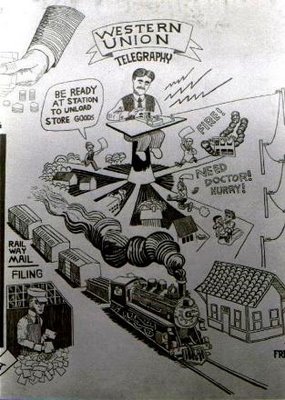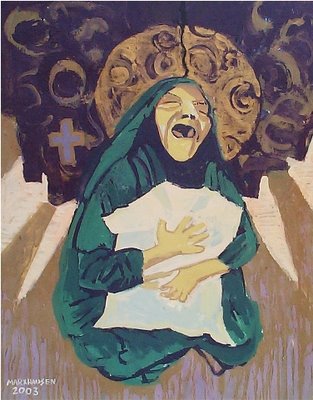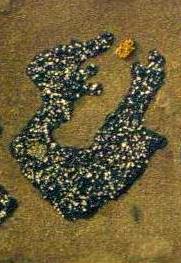Being an artist means you have to work out the details. Whether I am working on an outdoor landscape, doing a portrait, or composing a scene for a wall mural. There always is homework involved. The mural I did for the city of Carrollton in 1997 had all kinds of particulars. Split rail fences,choice of garden vegetables, settlers on foot, a covered wagon, a team of oxen,folks building a log cabin, a farmer behind a one mule plow, all of which needed drawings, color studies, transparencies---really a lot of work. The Land Of Opportunity is 37 feet wide and 20 feet tall. It is located one block east of the downtown square, on the NE corner of Virginia and Washington.Carrollton is located north and east of Kansas City, MO about 80 miles. About an hour's drive west of Columbia. About an hour's drive south of Chillicothe. About an hour's drive north of Sedalia. Go to Hwy 23 at the Concordia exit on Interstate 70. Go North on 23 to Waverly. Turn North on Hwy 65-24 to Carrollton about 10 miles. At Hwy 24 Exit, take a left over via duct, down hill to stop sign, up the hill to downtown stop sign, circle around square one way (counter clockwise). The south side of square is Washington Street. Go one block east of square, look to the left side, Maxine's restaurant has fenced in parking there. The south side of Maxine's has the mural. Stop and take a picture!In 1996 I was doing research on the western murals in Toppenish, Washington. I checked out all the vacant walls around our city. I came up with a design and even drove to Kansas City to meet with a Bank Midwest representative to ask permission to paint on their bank branch wall in Carrollton. They were more interested in a dominant bank logo. They declined. The idea sat on the shelf for a whole year. One day Don Lock of the Lock Steel Company expressed interest in the project. They agreed to provide the wall and the paint. I did the labor--200 hours of it. The work I poured into that wall landed me a contract with the Chillicothe Industrial Developement Corporation. In 1998 I completed a 100 foot by 60 foot mural in Chillicothe, Missouri and was paid two thousand dollars for supplies and labor.
Chillicothe Business College mural 1998
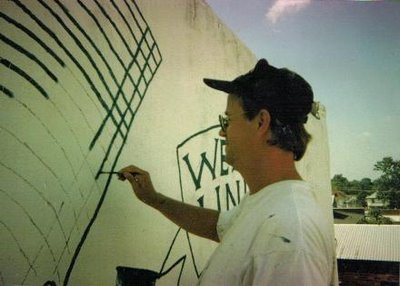 Ten foot illustrations outlined by brush atop scissors lift
Ten foot illustrations outlined by brush atop scissors lift.
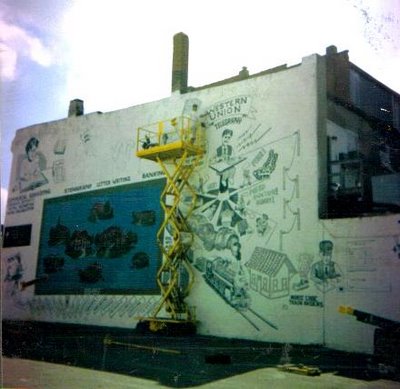
For the Chillicothe mural I researched the Business College yearbooks at their city library. Every time I drove up it was was a 30 mile commute one way. The CIDC approved large illustrations which depicted classwork offered through the school during the 1800s. Telegraphy and the railroad,
penmanship and bookkeeping, and a chapter of students from every state of the Union and several foreign countries. Ten years after the mural was completed, the CIDC hired a new artist to paint over the entire wall with a new design.
film documenting the making of the Carrollton mural.The old peeling paint was power washed off with water to preserve the soft red brick. The wall was given two primer coats with a power sprayer (that tended to clog up and needed frequent cleaning). A local man showed me that all the colors couold be hand mixed from red, blue, yellow, white, and black. But there came that moment of truth when that THEORY was tried out---and it did work. I used a glossy oil enamel paint. The color were hand mixed in two liter soda containers and reused milk jugs. To mix green I used black and yellow.
If you have plug-ins added you can view this short video clip. Click on triangle above. This shows where the Marxhausen mural is located in our village.The sorrel mule comes down the wall towards the viewer. This was a challenge since most photos of mules are either a side view or head on. I looked at Thomas Hart Benton lithographs and numerous sources to solve my problem. Here, you can learn more on painting sorrel mule.Several outline transparencies were made. One for the mule. One for the farmer. One for the builders on the hill. One for the covered wagon. At night by street light the image was projected on the wall atop a scaffold. I up on a ladder, using a black marker, to drawn the outlines on the prepared brick surface. Angels must have kept the projector from falling over. Answered prayers for sure.It was cool to be working at night. Teenagers driving by saw me working, pulled in to the parking area, and were asking me what I was doing. What a blast. I loved it. 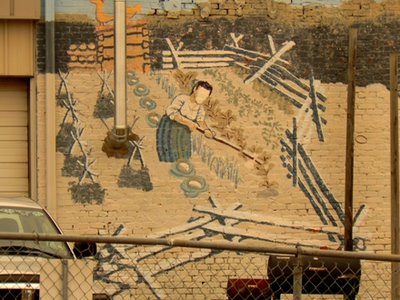 Left side - garden scene
Left side - garden scene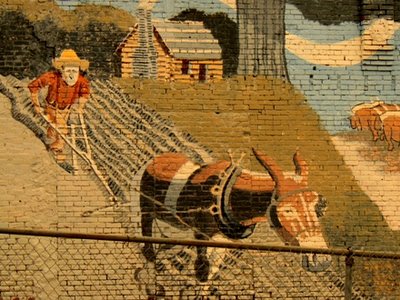
Middle - plowing scene
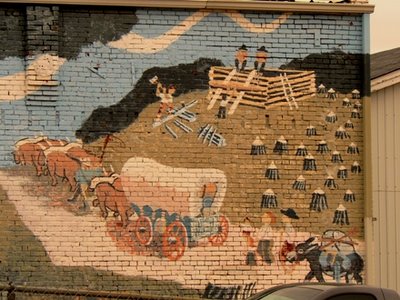
Right side - wagon train and building log house
Click triangle to zoom in on mural signature
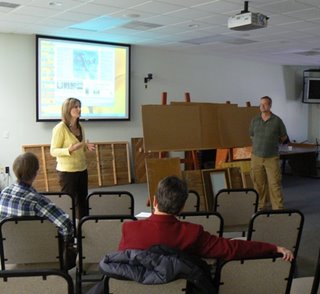 Following the question and answer time after the movie,the guest artist from De Witt was introduced.See next posting.
Following the question and answer time after the movie,the guest artist from De Witt was introduced.See next posting.
